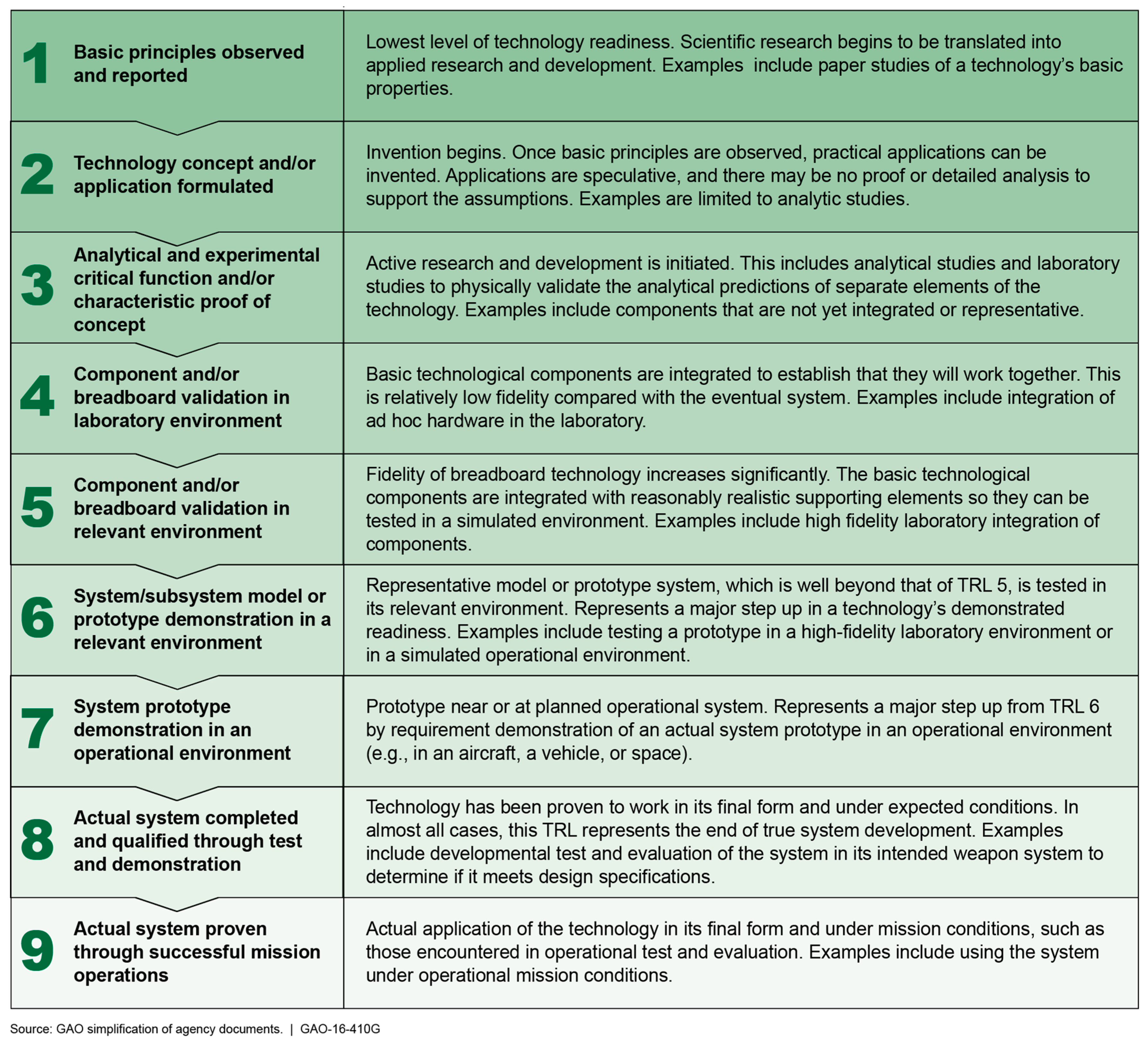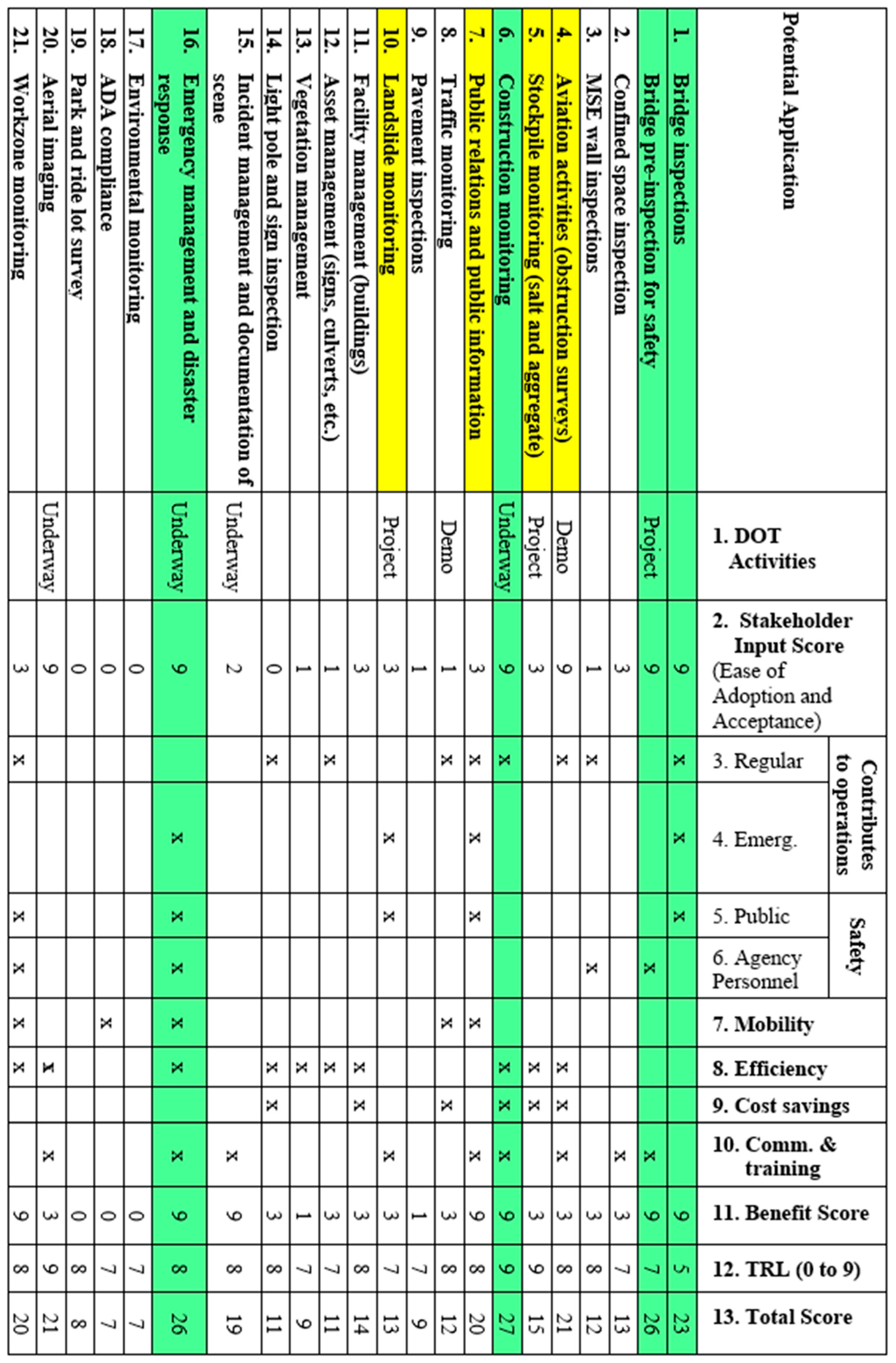A Method for Selecting Strategic Deployment Opportunities for Unmanned Aircraft Systems (UAS) for Transportation Agencies
Abstract
1. Introduction
Overview of UAS Applications for DOTs
- Photo/video;
- Surveying;
- Infrastructure inspections;
- Emergency response/natural disasters;
- Public education and outreach.
2. Method
- Stakeholder acceptance and ease of adoption;
- Benefits;
- Technical feasibility.
2.1. Assessment Areas
2.1.1. Stakeholder Acceptance and Ease of Use
2.1.2. Benefits
2.1.3. Technical Feasibility
2.2. Combine Assessment Information into an Evaluation Score
3. Results of a Case Study at a State DOT
3.1. Assessment Results: Stakeholder Input
3.2. Assessment: Benefits
- Contributes to the operation of the transportation system during regular operations;
- Contributes to the operation of the transportation system during emergency situations;
- Increases transportation system safety for the traveling public;
- Increases safety for the DOT workforce;
- Increases mobility for the traveling public.
- Improves efficiency;
- Provides cost savings;
- Supports communications, education, and training.
3.3. Assessment: Technical Feasibility
3.4. Evaluation: Combining Information from Assessmen Areas
3.5. Prioritization of Potential Applications
- Bridge inspection and pre-inspection safety;
- Emergency management and disaster response;
- Construction.
4. Discussion
- UAS for bridge inspection safety will be used in regular operations by DOT personnel;
- UAS for emergency management and disaster response will be used in emergency operations by DOT personnel;
- UAS for construction will be used in construction activities by consultants under contract to the DOT.
4.1. Bridge Inspection Safety
4.2. Emergency Operations
4.3. Construction
- Construction progress monitoring;
- Safety surveillance;
- Quality assurance;
- Documentation of work zone traffic control after an incident;
- Quantity measurement;
- Communication with stakeholders (use of video and images).
4.4. Other Applications
5. Conclusions
Author Contributions
Funding
Acknowledgments
Conflicts of Interest
References
- Ameri, B.D. Drones Applications: Disaster & Emergency Management. ASPRS Annual Conference 2009. Baltimore, MD. Available online: http://www.asprs.org/a/publications/proceedings/baltimore09/0007.pdf (accessed on 4 June 2020).
- Karpowicz, J. UAVs for Law Enforcement, First Response & Search and Rescue (SAR). Commercial UAV Expo 2016. Available online: http://expouav.com/wp-content/uploads/2016/04/free-report-uavs-for-search-and-rescue.pdf?_ga=1.203618320.1457496562.1470944392 (accessed on 4 June 2020).
- Gillins, D.T.; Parrish, C.; Gillins, M.N.; Simpson, C. Eyes in the Sky: Bridge Inspections with Unmanned Aerial Vehicles (No. FHWA-OR-RD-18-11); Federal Highway Administration: Washington, DC, USA, 2018.
- Kim, S.I. Potential Factors Influencing the Performance of Unmanned Aerial System (Drones) Integrated Safety Control for Construction Worksites; Construction Research Congress: Boca Raton, FL, USA, 2016; pp. 2614–2623. [Google Scholar] [CrossRef]
- Vlieg, L.E. Drones Take Flight despite Uncertain Regs. In ENR: Engineering News Record; BNP Media, Inc.: Troy, MI, USA, 2015; Volume 275. [Google Scholar]
- Koch, C.G. A Review on Computer Vision Based Defect Detection and Condition Assessment of Concrete and Asphalt Civil Infrastructure. Adv. Eng. Inform. 2015, 29, 196–210. [Google Scholar] [CrossRef]
- Schnebele, E.T. Review of Remote Sensing Methodologies for Pavement Management and Assessment. Eur. Transp. Res. Rev. 2015, 7. [Google Scholar] [CrossRef]
- Dorsey, T. State DOTs Using Drones to Improve Safety, Collect Data Faster, and Cut Costs. News Release 2016, March 27. Available online: https://news.transportation.org/Pages/NewsReleaseDetail.aspx?NewsReleaseID=1466 (accessed on 4 June 2020).
- McGuire, M.; Rys, M.J.; Rys, A. A Study of How Unmanned Aircraft Systems can Support the Kansas Department of Transportation’s Efforts to Improve Efficiency, Safety, and Cost Reduction (No. K-TRAN: KSU-15-3, 2016); Kansas. Dept. of Transportation. Bureau of Research: Topeka, KS, USA, 2016. [Google Scholar]
- AASHTO. Survey Finds a Growing Number of State DOTS Are Deploying Drones to Improve Safety and Collect Data Faster and Better 2018. Available online: https://adobeindd.com/view/publications/12579497-56a5-4d8a-b8fe-e48c95630c99/1/publication-web-resources/pdf/Drones’18cc.pdf (accessed on 4 June 2020).
- Lovelace, B.; Principal Investigator Collins Engineers Inc. Unmanned Aer Veh. Bridge Insp. Demonstr. Proj. Res. Proj. Final Report 2015-40; Minnesota Department of Transportation: St. Paul, MN, USA, 2015.
- AASHTO Special Report: The Evolution of Drones Part 3, Building Highways in the Sky 2019. Available online: https://www.transportation.org/the-evolution-of-drones-part-3/ (accessed on 4 June 2020).
- Li, Y.; Liu, C. Applications of multirotor drone technologies in construction management. Int. J. Constr. Manag. 2019, 19, 401–412. [Google Scholar] [CrossRef]
- Congress, S.; Puppala, A. Innovative Monitoring of Pavements on Expansive Soils Using Aerially Collected Data from UAV-CRP Technology. In Proceedings of the Transportation Research Board Annual Meeting, Paper No. 19-03664, Washington, DC, USA, 13–17 January 2019. [Google Scholar]
- Yahia, C.N.; Scott, S.E.; Boyles, S.D.; Claudel, C.G. Unmanned Aerial Vehicle Path Planning for Traffic Estimation and Detection of Non-Recurrent Congestion. arXiv 2018, arXiv:1807.11660. [Google Scholar]
- Jalayer, M.; O’Connell, M.; Zhou, H.; Szary, P.; Das, S. Application of UAV to Inspect and Inventory Interchange Assets to Mitigate Wrong-way Entries. In Proceedings of the Transportation Research Board Annual Meeting, Paper No. 19-05114, Washington, DC, USA, 13–17 January 2019. [Google Scholar]
- Park, K.; Ewing, R. A New Tool for Pedestrian Observation: Reliability and Efficiency of Small UAS. In Proceedings of the Transportation Research Board Annual Meeting, Paper No. 19-00140, Washington, DC, USA, 13–17 January 2019. [Google Scholar]
- Cai, Q.; Abdel-Aty, M.; Zheng, O.; Yue, L. Developing a Crash Warning System for the Bike Lane Area at Intersections with Connected Vehicle Technology. In Proceedings of the Transportation Research Board Annual Meeting, Paper No.19-00596, Washington, DC, USA, 13–17 January 2019. [Google Scholar]
- Plotnikov, M.; Ni, D.; Collura, J. The State of the Practice of Unmanned Aircraft Systems in State Departments of Transportation. In Proceedings of the Transportation Research Board Annual Meeting, Paper No. 18-03694, Washington, DC, USA, 7–11 January 2018. [Google Scholar]
- Davis, F.D. Perceived Usefulness, Perceived Ease of Use and User Acceptance of Information Technology. MIS Q. 1989, 13, 319–340. [Google Scholar] [CrossRef]
- Vankatesh, V.; Morris, M.G.; Davis, G.; Davis, F.D. User acceptance of information technology: Toward a unified view. MIS Q. 2003, 27, 425–478. [Google Scholar] [CrossRef]
- Vance, M.; Carstens, J.; Gasper, M.; Parker, P. Quantitatively Exploring Human Preference. J. Manag. Sci. Bus. Intell. 2018, 3, 15–30. [Google Scholar]
- Government Accounting Office (GAO). Technology Readiness Assessment Guide; Report GAO-16-410G; U.S. Government Accountability Office: Washington, DC, USA, 2016.
- INDOT Mission, Goals and Values. Available online: https://www.in.gov/indot/2341.htm (accessed on 4 June 2020).
- FHWA Unmanned Aerial Systems (UAS) 2019. Available online: https://www.fhwa.dot.gov/innovation/everydaycounts/edc_5/uas.cfm (accessed on 4 June 2020).
- Irizarry, J.; Costa, D.B. Exploratory study of potential applications of unmanned aerial systems for construction management tasks. J. Manag. Eng. 2016, 32, 05016001. [Google Scholar] [CrossRef]
- OSHA Motor Vehicle Safety 2017. Available online: https://www.osha.gov/SLTC/motorvehiclesafety/ (accessed on 4 June 2020).


| Roadway and Bridge | Construction | Emergency Response | Environmental Monitoring | Airport and Aviation | Other |
|---|---|---|---|---|---|
| Bridge 1 and culvert inspection | Confined space inspection | Fugitive and missing person tracking | Agricultural monitoring | Airport obstruction monitoring | Advertising and public information |
| High mast pole inspection | Construction inspection | Crash investigation | Environmental compliance 2 | Airport perimeter control | Building and structural inspections |
| Unpaved road monitoring | Pipeline inspections | Emergency management | Disposal area inspection | Aerial monitoring | Media relations |
| Pavement inspections | Railroad inspection | First responder information | Sinkhole monitoring | Heritage inspections 3 | |
| Traffic monitoring | Surveying and photogrammetry | Avalanche control | Waterway inspection | Dam and dyke inspections | |
| ROW studies | Stockpile measurement | Earth slides | Wildlife surveys | Pedestrian and bike studies 4 | |
| Corridor analysis | Work zone audits | Rockfall inspections | Delivery |
| Sample Stakeholders | Areas of Greatest Interest |
|---|---|
| DOT personnel Bridge Aerial imaging and aviation Logistics Districts Maintenance Traffic monitoring Safety Emergency management Construction Environmental services Consultants Other state agencies that have deployed UAS Personnel from other state DOTs that have completed UAS research and deployed UAS Law enforcement Local transportation agency personnel Personnel that have deployed UAS in related sectors (e.g., rail) University partners conducting DOT sponsored research | Bridge inspection Confined space inspection Construction activities Facility management (buildings) Landslide monitoring MSE wall inspection Pavement inspection Public relations and public information Stockpile monitoring Traffic monitoring Aviation obstructions for airports on state airport system |
| General Area | DOT Suggested Applications and Tasks |
|---|---|
| Bridge Inspection | Pre-inspection safety check for bridge inspector |
| Aerial imaging to reduce the need for snooper truck and lane closures | |
| Aerial imaging to inspect joints, rust, and critical areas | |
| Emergency Management and Disaster Response | Provide live video feed to operation center |
| Assist in determination of emergency egress routes | |
| Support emergency coordination with other states | |
| Support inspection after earthquake | |
| Inspect underneath side of bridge if concern for collapse | |
| Support monitoring and corrective action for earth slides | |
| Construction Activities | Aerial imaging of future large construction projects |
| Document work zone traffic set-up for liability issues | |
| Check temporary traffic controls used for construction and maintenance | |
| Monitor stockpile and excavation volumes | |
| Aviation Obstructions and Airport Support | Aerial imaging for airport obstacle analysis |
| Check visibility of lighted windsocks (wind cones). | |
| Public Relations and Public Information | Support public communication |
| Support marketing and recruitment efforts | |
| Traffic Monitoring | Support accident incident response and re-routing traffic |
| Support determination of line of site on roads | |
| Document traffic issues | |
| Asset Management (includes INDOT Signs, Culverts, etc.) | Correct sign placement |
| Inspect culverts | |
| Identify assets along a corridor | |
| Pavement inspections | |
| Vegetation and Environmental Management | Support vegetation management including classification of plant species |
| Support environmental management such as watershed areas | |
| Aerial Imaging | Support aerial imaging traditionally done by fixed wing aircraft |
| Provide photogrammetry and surveying information |
© 2020 by the authors. Licensee MDPI, Basel, Switzerland. This article is an open access article distributed under the terms and conditions of the Creative Commons Attribution (CC BY) license (http://creativecommons.org/licenses/by/4.0/).
Share and Cite
Hubbard, S.; Hubbard, B. A Method for Selecting Strategic Deployment Opportunities for Unmanned Aircraft Systems (UAS) for Transportation Agencies. Drones 2020, 4, 29. https://doi.org/10.3390/drones4030029
Hubbard S, Hubbard B. A Method for Selecting Strategic Deployment Opportunities for Unmanned Aircraft Systems (UAS) for Transportation Agencies. Drones. 2020; 4(3):29. https://doi.org/10.3390/drones4030029
Chicago/Turabian StyleHubbard, Sarah, and Bryan Hubbard. 2020. "A Method for Selecting Strategic Deployment Opportunities for Unmanned Aircraft Systems (UAS) for Transportation Agencies" Drones 4, no. 3: 29. https://doi.org/10.3390/drones4030029
APA StyleHubbard, S., & Hubbard, B. (2020). A Method for Selecting Strategic Deployment Opportunities for Unmanned Aircraft Systems (UAS) for Transportation Agencies. Drones, 4(3), 29. https://doi.org/10.3390/drones4030029






